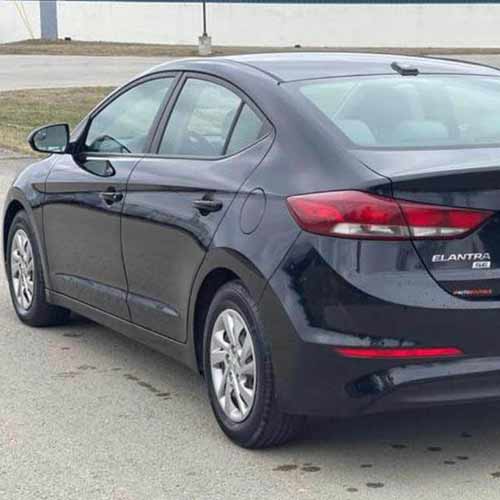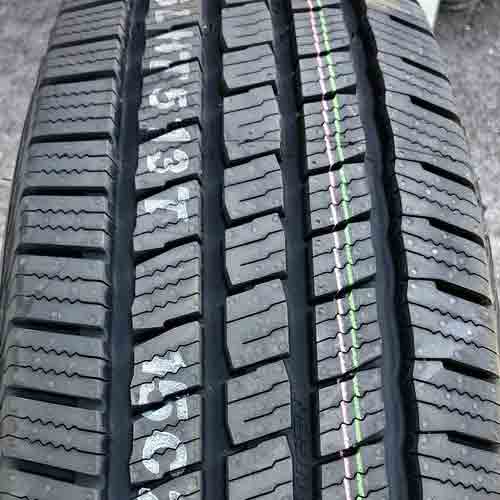Meet the Kumho Crugen HT51, a tire that stands as a beacon of stability and performance in the most demanding driving conditions. Its innovative design featuring a stiff center block and asymmetrical tread design guarantees prolonged tread life and unmatched grip and braking performance. But is this tire an all-weather champion? Well, let’s find out!

Available Sizes (Specs)
The Kumho Crugen HT51 comes in inches wheels, and they come with the following specifications.
- Speed ratings: T only.
- Load ratings: SL, XL, C, D and E.
- Tread depth: 12.5 to 14.5/32″
- Weight range: 24 to 56 lbs.
- Treadwear warranty: 70k for P metric and 45k for LT sizes.
- UTQG rating: 720 A A.
Tread Structure
The Crugen HT51 features an asymmetric tread design of 5 total ribs.

The 3 central ribs features a very open design, where they form prominent 4 longitudinal grooves joined up by lateral voids.
All lugs on these ribs are very blocky, and all of them have off-set edges (which act as biters).
Moreover, they also have a combination of lateral and wave-like siping (so you get enhanced wet traction).
Moving on, the shoulder ribs are slightly different on each side.
On one (left most in the image), you see proper lateral grooves, whereas on the other, lugs are more packed up and have in-groove notches.
Both of them, though, have interlocking siping which are a little more pronounced compared to the ones in the middle.
Compare Kumho Crugen HT51 With Other Highway All Season Tires
Winter Performance
The tire’s aptness for winter driving is gauged by its behavior on snow and ice, focusing on stability, control, and acceleration capabilities.
In these considerations, the Kumho Crugen HT51 gives you a pretty commendable performance, and so it makes sense why the tire comes with the 3-Peak Mountain Snowflake certification.
Side note: This snow rating is only given to tires coming in (manufactured) after April, 2017, and not before. Learn more about 3PMSF and M+S rating.
However, the tire is equipped with a substantial quantity of biters, and its interlocking sipes proficiently capture snow particles, allowing for enhanced snow-to-snow connection, thereby optimizing its performance on snowy tracks.
And this type of contact is pretty important for winter traction, as snow particles have unique interlocking arms (talking about snowflakes here). And so they intermingle with each other pretty easily, allowing for greater friction.
This friction can not be generated with snow to tread’s rubber contact, on the other hand.
Highway Performance
The overall dry performance can be divided in to 2 main sections, traction, and the overall steering response. Let’s start with tire’s gripping first.
Overall Traction
Traction is further divided in to 2, dry grip and lateral traction.
Dry grip is directional, as it’s the longitudinal grip of a tire measured in a straight line travel (that’s why its calculated by braking efficacy of a tire).
And let me tell you the Kumho Crugen HT51 did not impress with its lacking braking distances.
Although this tire features three longitudinal ribs at the center, they aren’t streamlined enough, diminishing its directional grip slightly.
Additionally, the presence of broad, all-terrain-tire like lateral grooves and circumferential channels means the tire forfeits a substantial amount of rubber that could have been in contact with the road, improving grip.
(See difference between all terrain and all season tires).
Though the tire still offered above average lateral traction, and it makes sense since its shoulders are a little more compact, in comparison, with smaller lateral tread voids in between, and reinforced foundations (meaning the lugs are connected with each other with rubber ridges in between, providing stability).
Side Note: The importance of the tire shoulders in lateral traction becomes apparent when considering the increased weight they bear during turns due to centripetal force, affecting the vehicle’s direction as it corners. In simpler terms, when the tire turns, the shoulders get the most weight, as they connect with the road with greater force.
Steering Feedback
Now, even though the tire provides adequate traction, its overall lack in steering response still resulted in slower lap times compared to other tires in its category.
In essence, this tire demands precise and thoughtful steering and acceleration to prevent the front tires from losing grip in corners or the rear tires from spinning when exiting them.
Dealing with quick wheel-spin when exiting corners and long braking distances means you, as the driver, need to adapt significantly to handle the tire well.
So, why does this happen?
Its heavier build and softer tread compound create more inertia as the tire goes around corners, making it occasionally harder to control. Also, its deeper tread disturbs the balance between oversteering and understeering.
Essentially, the tire bears a lot of weight, and the deeper tread means the lugs (the parts of the tire that stick out) are more likely to bend, mostly in the opposite direction of the lateral cornering force.
This bending results in a delay between when you turn the steering wheel and when it responds.
Fuel Efficiency
The fuel consumption of a tire is contingent upon various elements such as its design, construction, and the specific circumstances under which it operates.
That’s why considering all it makes sense why Kumho Crugen HT51 fuel consumption varies so much across its sizes.
So the SL (Standard Load) and some XL (Extra Load) sizes, characterized by their lower weight and smaller tread depth, typically excel in fuel efficiency compared to LT (Light Truck) sizes.
The reduced weight ensures less pressure is exerted on the lugs as they roll on the road, and a shallower tread depth results in more tread rigidity.
Basically with minimized lug flexing, less energy is expended, allowing more to be concentrated on the actual rolling of the tire.
And of course, needless to say, this optimization in energy allocation invariably improves the tire’s miles per gallon (MPG), thereby enhancing fuel efficiency.
Wet Traction
Just like the dry, the wet performance of the Kumho Crugen HT51 has a similar issue. Where the tire does offer decent grip, but lacks in handling.
I mean you get pretty competitive wet braking thanks to it’s combination of interlocking (wave-like) and rectilinear sipes. And same goes for its wet lateral traction, where its bulky shoulders with similar interlocking full depth sipes and in-groove notches provide the needed sideways grip.
But still the overall wet lap times (on average) were lacking compared to other highway terrain tires in the category.
When on a driving seat with these tires, one has to be precise and deliberate with the control inputs, where the most challenging aspect involves straightening the vehicle before applying acceleration to avoid loss of control.
Trying to accelerate and turn simultaneously often leads to quick oversteer with this tire. Though the good thing is that its still pretty manageable, though you have to be a little more experienced as a driver.
Though the good thing about this tire is its one of the best resistance to hydroplaning, where you get leading scores in terms of straight running and curved aqua tests.
This has to do with its ample tread depth going up to 14.5/32″, allowing more volume of water to be evacuated at a given time (in reference, its closest competitor, the Firestone Destination LE3 only goes up to 10/32″).
Moreover, the tire’s spacious tread voids are help here a lot.
Ride Quality
I sum up ride quality with 2 elements, how much a tire generates noise on road, and how well it settles the surface imperfections.
In both these dimensions, although there’s no WOW moment with these tires, they don’t disappoint either.
Noise
If I get to the basics, the sound associated with tires is due to air movement.
Air (for the most part), comes in the tread (as the tire rolls), and their hitting the tread walls is what creates the noise.
Now since most of those air particles are coming in through the shoulder area, the Kumho Crugen HT51 with pretty packed up lugs there try to cut down noise generation at the source.
Though still, as the tire is pretty voided up in the middle (compared to other HT tires, I mean), you still get a somewhat consistent white noise at a moderate volume.
But it would have been much greater if it weren’t for the tire’s advanced pitch sequencing technology where lugs are made with varying angles. So air particles hitting them could create differentiating tones which won’t amplify together.
Impact Comfort
Impact comfort has to do with how well the tire gets to soak up road shocks.
And here the Kumho Crugen HT51 coming in with a softer compound with greater tread depth (compared to others in the category), gets to dissipate road shocks and vibrations pretty nicely, providing smoother driving experience.
I mean compared to its direct highway terrain peers, it has the softest tread compound, and its tread depth goes up to 14/32″ where most of them are stuck with 10.
Deeper tread voids, basically provide a larger rubber area, so bumps have more room to settle down before the reach the driver’s seat.
Though keep in mind, that deeper tread is only provided in LT sizes.
Tread Life
The longevity of a tire’s tread is determined by finding the right balance between rolling resistance, tread depth, and composition.
But why is that? Well tires with stiffer rubber, would naturally fight off excessive wear, and here tread depth tells you about how long it would take the rubber to reach down to the replacement levels.
Having said that, the Kumho Crugen HT51 offers very varying tread life considering both LT and P metric sizes, where of course the non LT sizes do much better.
That’s why there’s so much difference in their warranties, I mean the tire offers 70k miles for its P metric sizes where the LT only gets 45k.
Side Note: It’s tread life is very comparable to the Michelin Defender LTX MS (review).
To Sum Up
The Kumho Crugen HT51 stands out with diverse performance attributes, showcasing distinctive strengths and areas for improvement across various metrics.
It excels in wet conditions and snow, with specialized tread designs contributing to impressive traction and hydroplaning resistance. However, it falls short in dry, particularly in braking distances (directional grip), which also affects its overall handling.
Though the tire balances it with its notable impact comfort and minimized noise levels, thanks to its softer compound and advanced construction.
Moreover, with solid reinforced foundations underneath its lugs, you also get above average tread life and fuel economy. Though this only goes for P metric sizes.